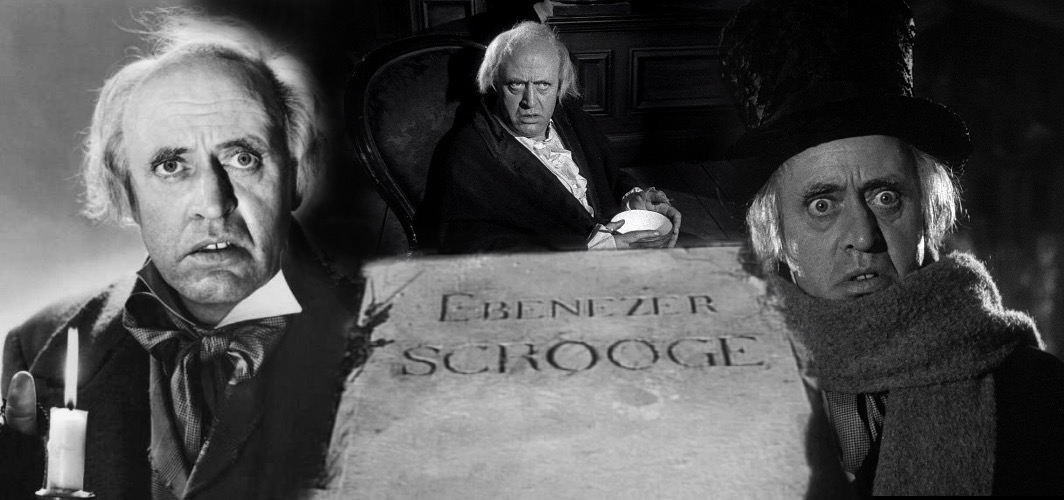
Alastair Sim in a Movie Version of “A Christmas Carol”
Dear Commons Community,
The New York Times this morning has a featured article entitled, Bah Humbug!, How Theaters Are Saving “A Christmas Carol.” It describes theaters throughout the country that will continue their traditions of staging Charles Dickens’s novella. Here is an excerpt:
“For all his flaws, that cranky old miser Ebenezer Scrooge has been a godsend for American theaters. Through recessions and blizzards and other upheavals, he has drawn small children and big money to his redemption story in “A Christmas Carol.”
Stage adaptations of the tale, which generally run between Thanksgiving and year-end, have been a tradition and a lifeline for troupes big and small, professional and amateur. But now, after decades in which the Dickens classic has sustained them, this year theaters are sustaining Dickens.
Gone are the large-cast extravaganzas playing before cheery crowds in packed venues. Instead, theaters are using every contagion-reduction strategy they have honed during the coronavirus pandemic: outdoor stagings, drive-in productions, street theater, streaming video, radio plays and even a do-it-yourself kit sent by mail.
Many of these theaters are willingly running the long-lucrative show at a loss — they are hungry to create, determined to stay visible and eager to satisfy those “Christmas Carol” die-hards who don’t want to miss a year.
“It’s absolutely an obligation, in the best sense of that word,” said Curt Columbus, the artistic director of Trinity Repertory Company, in Providence, R.I., which has staged “A Christmas Carol” each holiday season since 1977. “The story felt more urgent, and more necessary, than it has in many years.”
A filmed performance by Mr. Mays will be streamed this year to benefit regional theaters, and a second version, with more special effects, will be marketed next year to streaming services.
A primer for those who don’t know a Cratchit from a Fezziwig: “A Christmas Carol” is an exceptionally durable novella, written by Charles Dickens and published in 1843, about the transformation, via a series of ghostly visitations, of a wealthy businessman (that’s Scrooge) from mean and miserly to caring and charitable.
Dickens himself performed readings of the story for more than two decades, with stops in America as well as Britain, until his death in 1870; it has been repeatedly adapted for stage and screen, and the story, in one form or another, has been a seasonal staple of the American regional theater since the 1970s. Last year a critically lauded adaptation from England’s Old Vic theater reached Broadway; this year, it will be livestreamed from its London home, fully staged but audience-free.
“‘A Christmas Carol’ does everything we talk about when we talk about theater — it builds community, and it tugs us toward our better selves,” said Joseph Haj, the artistic director of the Guthrie Theater in Minneapolis, which has staged the story since 1975, last year selling 57,900 tickets to the show. This year, the Guthrie will stream a retelling by four actors; it will cost $10 to watch, and will be free for schools.
Mr. Haj doesn’t expect to make money on it. Nor does Leda Hoffmann, artistic director of the Contemporary American Theater Company in Columbus, Ohio, which, for $20 per device, will stream a contemporary reimagining with Ebony Scrooge at its center. “This is very likely a losing proposition, but we’re telling the story because we want to tell it,” she said.
The financial implications are enormous, especially for those that have opted not to charge at all. Ford’s Theater in Washington last year sold $2.5 million worth of tickets to “A Christmas Carol.” This year, it is releasing a free audio version on its website and on public radio, paid for by corporate sponsorships and donations. “Hopefully it will come back to us in other ways,” said Paul R. Tetreault, Ford’s director.
The money “A Christmas Carol” usually brings in allows theaters to perform more challenging work at other times of the year.
In Raleigh, N.C., where Ira David Wood III, the artistic and executive director of Theater in the Park, has been playing Scrooge in a musical adaptation since 1974 (he missed one year, when he had open-heart surgery), the money earned from the holiday show “enables us to do ‘Uncle Vanya’ and play to maybe 12 people,” he said.
Like many major regional theaters, Providence’s Trinity Rep is enormously dependent on the show, which accounts for half of all annual sales. This year, its one-hour streaming version looks still to be popular — in the first 72 hours, 75,000 people from 46 states signed up to watch. But ticket revenue, which last year topped $1.7 million, will be zero, because the video is being aired for free.
“This thing has kept American theaters alive for decades and decades,” said Charles Fee, the producing artistic director of Great Lakes Theater in Cleveland. “Without ‘Christmas Carol,’ our company would almost certainly have failed.”
I personally love the ending of Dickens’s tale:
“The visit to the future ends as Scrooge faces his own mortality in the form of a tombstone inscribed with his name. He asks the Ghost:
“Before I draw nearer to that stone to which you point, answer me one question. Are these the
shadows of the things that Will be, or are they shadows of things that May be..?”
The Ghost continued to point downward to the grave by which it stood.
“Men’s courses will foreshadow certain ends, to which, if persevered in, they must lead,” said
Scrooge. “But if the courses be departed from, the ends will change. Say it is thus with what you
show me!” (Dickens, 1843)
Amen!
Tony



One comment